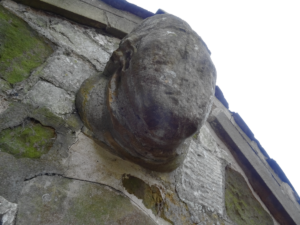The manor which formed the endowment of the priory of Covenham was granted in 1082 by William the Conqueror to the abbot and convent of St. Carileph, Le Mans, at the request of the bishop of Durham, who had formerly been a monk of that abbey. A small Benedictine priory was built here soon after, but it is probable that there were never more than two monks, or perhaps only one to take charge of the estate. The advowson remained with the bishops of Durham.
In 1303 the cell had become so far unprofitable to the abbey of St. Carileph that licence was sought from the king to sell it to the abbot and convent of Kirkstead. It was then in possession of the original manor of two carucates in Covenham, Grainthorpe, Skidbrook, and Little Grimsby, with the advowson of the church of Covenham, and was charged with a corrody due to Robert Merle of Swinthorpe.
That’s about all the certainty we have of the priory. As stated elsewhere, Covenham was a wealthy settlement back in the day so, after the conquest, it was not uncommon to place a couple of monks in such places to keep an eye on the locals. After all, William wanted to make sure he got all of his taxes.
Some seem to think that the original site of the “lost” priory was that of St. Mary’s but part of the fun in history is coming up with your own theories so here is another one with circumstantial evidence that the priory might have been in the vicinity of Grange Farm at the north end of Covenham.
St. Bartholomew’s was the minster church to the prior, established long before St. Mary’s and of Saxon or earlier provenance. An extract from The East coast of England from the Thames to the Tweed (1861) states “Covenham St. Bartholomew, 6m. N.E. of Louth – The church, Early English, was the minster of a Benedictine Priory, founded in the reign of William I. It was cruciform without aisles, but with central tower; the N. transept has been destroyed. It contains a brass to Sir J. Skipwith, and a beautiful octagonal font with rich imagery.”
The priory was known as “The Grange” in one source and, at the end of “Grange Lane” is “Grange Farm” formally known as “The Grange”. This is also the site of Calthrop (or Cawthorpe) St. Bartholomew where Sir J. Skipwith lived. He had a licence to hold mass in a chapel where he lived. There also appears to be a silted up fish pond at the end of Grange Lane as the road turns right, check out an old OS map.
In the photo below is a priors head, this rather weathered sculpture is on the porch at St. Bartholomew’s but there is no record of a prior being resident at the church.
Most records relate that the Priory end up in the hands of the abbot of Kirkstead in 1303 when it became unprofitable. However there is a much juicier story to be told that probably reflects standards of the time.
Lincoln was a sea port, the Witham was a tidal river that could take large ships and smuggling was rife with a lot of money to be made, the export of wool being particularly lucrative. The mayor of Lincoln and the Abbot of Kirkstead weren’t exactly the best of friends. The abbot seized part of the docks at one point and extorted taxes and dues bypassing the mayors coffers. Kirkstead employed freebooters (pirates) as enforcers and of course ensured their patrons (the landed gentry) got their cut to keep all those that mattered quiet. Anyone that made a fuss would always find the threat of excommunication being on the cards, that was a big deal back in the day!
Not wishing to hold back the abbot then obtained, from Edward I, a “Writ of ad quod damnum” (damages) against the mayor to transfer the “Alien Priory of Covenham with its lands in Grimsby, Skidbrooke and elsewhere and the advowson of Covenham Church to the abbey of Kirkstead”.
All a bit vague and we are still on the lookout for more information on this but whilst we might think of monks as kind, gentle souls that wasn’t necessarily the case. Kirkstead was a “well fortified and armed abbey”. It was at the dissolution when the Skipwith family appear on the scene and its possessions were granted to William Skipwith, John Skipwith’s father.
So, is the priors head an accidental addition or, maybe, some form of trophy or statement? The image below is a 3D view, you can make it full screen and rotate it.

The head over the porch door.